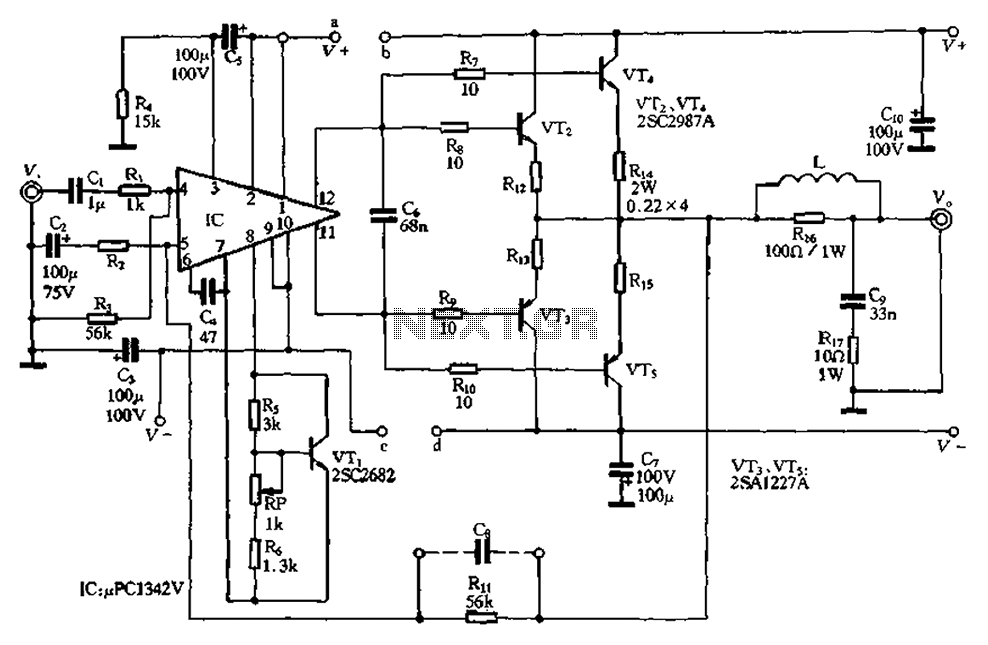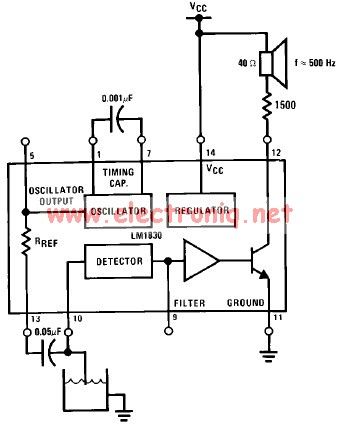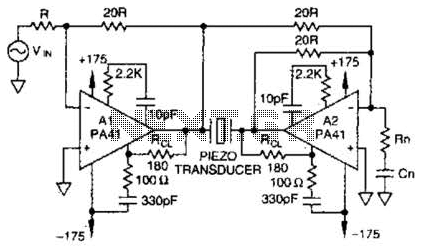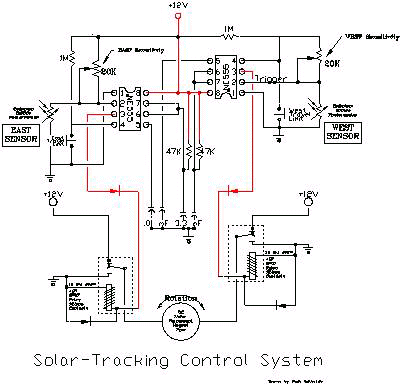
Compact 100W power amplifier circuit

The pLPC1342V and NE are two companies involved in a tube amplifier circuit utilizing 2SA1227A and 2SC2987A transistors, achieving a maximum output power of up to 120W with a cutoff frequency of up to 500 MHz. The circuit, illustrated in Figure 2-126, features a double tube parallel output stage designed to enhance output power. The circuit operates at a voltage of 45V, although the operating voltage can be increased to boost output power; however, this also raises power consumption and heat generation in the tube amplifier. To meet output power requirements, the supply voltage should be kept as low as possible. For the 2SC2987A/2SA1227A amplifier circuit, the final stage power supply should ideally not exceed 45V. The pLPC1342V can be used in a common power supply configuration for the final stage, or a separate power supply can be employed for the pre-amplifier and power amplifier stages. Pre-regulated power supplies may be utilized when sharing a single power source. Table 2-35 outlines the performance of the 1342V and the 2SC2987A, 2SA1227A amplifier circuit under various power supply voltages and testing conditions. The circuit demonstrates excellent frequency response, with an output power of 1W (8-ohm load) showing no significant transition curve characteristics in the frequency range from 10Hz to 100kHz. At 400kHz, the curve exhibits a drop of 2dB, while fidelity remains high, with harmonic distortion measured at 0.012% at 1kHz, 0.008% at 100Hz, and 0.005% at 100kHz.
The design of the tube amplifier circuit featuring the 2SA1227A and 2SC2987A transistors emphasizes the importance of efficient thermal management and power supply design to optimize performance. The double tube parallel output stage not only increases the output power but also enhances the overall fidelity of the amplifier. The choice of a 45V supply voltage serves to balance the need for high power output with thermal considerations, as excessive voltage can lead to increased heat generation, potentially affecting the reliability and lifespan of the tubes.
The circuit configuration allows for flexibility in power supply arrangements, accommodating both shared and separate power supplies for the pre-amplifier and output stages. This modular approach can enhance the performance of the amplifier by minimizing interference between stages and ensuring stable operation under varying load conditions.
In terms of frequency response, the amplifier circuit is well-suited for audio applications, with low harmonic distortion across a range of frequencies, indicating high fidelity in sound reproduction. The measured harmonic distortion values suggest that the circuit is capable of delivering clear and accurate audio signals, making it suitable for high-quality audio amplification. The performance metrics detailed in Table 2-35 provide valuable insights into the operational characteristics of the amplifier under different conditions, guiding engineers in the design and optimization of similar tube amplifier circuits. By the pLPC1342V and NE (two company names and fever on the tube amplifier circuit 2SA1227A 2SC2987A composed of maximum output power up to 120W, the cutoff frequency up to 500 MHZ. Its up to the state collector output current f 12Ao circuit shown in Figure 2-126 o shown by the ring shows that the output stage of the circuit is double tube parallel output, the purpose is to increase the output power. circuit voltage using 45V, operating voltage can be increased to improve the output power, but consumption and tube amplifier tube heat also increased, so the output power to meet the needs, the supply voltage should be as low as possible.
for 2SC2987A/2SA1227A composition amplifier circuit, the final stage of the power supply is preferably not more than 45Vo can pre-ppC1342V the last stage of a common set of power, you can also use a separate set of power level before and after the separate power supply, pre-regulated power supply can be used before and after class when sharing a set of power, you can figure a and b, c and d. linked to table 2-35 lists the time 1342V and 2SC2987A, 2SA1227A amplifier circuit composed at different power supply voltages and different forms of testing this circuit found: it has excellent frequency response, when the output power 1w (1 load 8.
the letter source frequency number changes from 10H to 100kHt, no transition curve characteristic base rate move; fo at 400kHz, the curve fell 2d30 rate machine fidelity is also very good, when when the output power of loow, lkHz: harmonic distortion of the signal 0 012%, 100HZ harmonic distortion of the signal 0.008%, harmonic distortion signal 100kHz 0.005% o.
The design of the tube amplifier circuit featuring the 2SA1227A and 2SC2987A transistors emphasizes the importance of efficient thermal management and power supply design to optimize performance. The double tube parallel output stage not only increases the output power but also enhances the overall fidelity of the amplifier. The choice of a 45V supply voltage serves to balance the need for high power output with thermal considerations, as excessive voltage can lead to increased heat generation, potentially affecting the reliability and lifespan of the tubes.
The circuit configuration allows for flexibility in power supply arrangements, accommodating both shared and separate power supplies for the pre-amplifier and output stages. This modular approach can enhance the performance of the amplifier by minimizing interference between stages and ensuring stable operation under varying load conditions.
In terms of frequency response, the amplifier circuit is well-suited for audio applications, with low harmonic distortion across a range of frequencies, indicating high fidelity in sound reproduction. The measured harmonic distortion values suggest that the circuit is capable of delivering clear and accurate audio signals, making it suitable for high-quality audio amplification. The performance metrics detailed in Table 2-35 provide valuable insights into the operational characteristics of the amplifier under different conditions, guiding engineers in the design and optimization of similar tube amplifier circuits. By the pLPC1342V and NE (two company names and fever on the tube amplifier circuit 2SA1227A 2SC2987A composed of maximum output power up to 120W, the cutoff frequency up to 500 MHZ. Its up to the state collector output current f 12Ao circuit shown in Figure 2-126 o shown by the ring shows that the output stage of the circuit is double tube parallel output, the purpose is to increase the output power. circuit voltage using 45V, operating voltage can be increased to improve the output power, but consumption and tube amplifier tube heat also increased, so the output power to meet the needs, the supply voltage should be as low as possible.
for 2SC2987A/2SA1227A composition amplifier circuit, the final stage of the power supply is preferably not more than 45Vo can pre-ppC1342V the last stage of a common set of power, you can also use a separate set of power level before and after the separate power supply, pre-regulated power supply can be used before and after class when sharing a set of power, you can figure a and b, c and d. linked to table 2-35 lists the time 1342V and 2SC2987A, 2SA1227A amplifier circuit composed at different power supply voltages and different forms of testing this circuit found: it has excellent frequency response, when the output power 1w (1 load 8.
the letter source frequency number changes from 10H to 100kHt, no transition curve characteristic base rate move; fo at 400kHz, the curve fell 2d30 rate machine fidelity is also very good, when when the output power of loow, lkHz: harmonic distortion of the signal 0 012%, 100HZ harmonic distortion of the signal 0.008%, harmonic distortion signal 100kHz 0.005% o.





